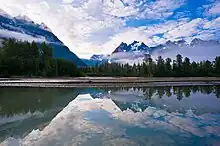Transboundary Watershed Region
The Transboundary Watershed Region is a region of northwest British Columbia and southeast Alaska that includes the Tatshenshini-Alsek, Chilkat, Chilkoot, Skagway, Taiya, Taku, Iskut-Stikine, Unuk, and Whiting watersheds. The region extends from high alpine tundra, through boreal landscapes and coastal rainforests, to the island marine environment of southeast Alaska, covering over 130,000 square kilometres (32,000,000 acres).

The land and rivers within these watersheds support populations of wildlife including: grizzly and black bears, moose, caribou, mountain goats, sheep, wolves, and rare migratory birds. The major rivers of the region are abundant with wild Pacific salmon.[1]
The "Transboundary Watershed Region" remains home to the Tlingit, Tahltan, Haida, Champagne-Aishihik and Carcross-Tagish First Nations, among others.[2]
 Taku Headwaters
Taku Headwaters Driftwood on the Taku
Driftwood on the Taku Waterfall on the Taku
Waterfall on the Taku
References
- Taku River Salmon Stock Assessment
- "About Rivers Without Borders". Rivers Without Borders. Retrieved 2010-10-30.